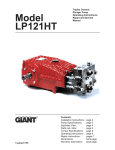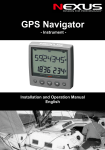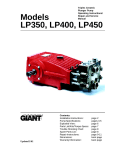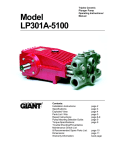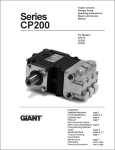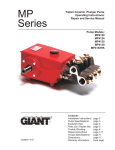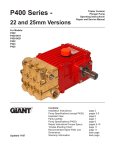Download Giant MP4130HT(C) User's Manual
Transcript
Model MP4130HT(C) Triplex Ceramic Plunger Pump Operating Instructions/ Repair and Service Manual Contents: Installation Instructions: Pump Specifications: Exploded View: Parts List / Kits: Repair Instructions: Torque Specifications: Trouble Shooting: Dimensions: Warranty Information: page 2 pages 3 page 4 page 5 page 6-10 page 10 page 11 back page back page INSTALLATION INSTRUCTIONS Installation of the Giant Industries, Inc., pump is not a complicated procedure, but there are some basic steps common to all pumps. The following information is to be considered as a general outline for installation. If you have unique requirements, please contact Giant Industries, Inc. or your local distributor for assistance. NPSHR (FT-HEAD) The MP4130HT has been especially constructed for pumping hot water e.g. steam boiler storage. The plunger seals (40) on the water side are made out of a high temperature-resistant material. Rinsing chambers behind the high pressure seals through which cold water can flow thus increasing the life of the seals are available upon request (MP4130HTC). The cold water connections (59) are suited to the Ermeto-pipe 6mm dia. The operator can use hose nipples instead if he wishes. There are 1/8" threads in the seal sleeve for this purpose. The cold water (50oF - 86oF) can be guided into the pump from either side and flows out on the opposite side e.g. into a drain. The cold water flow rate should be at least 0.13 GPM and must be put into use as soon as the pump is RPM started. If the cold water doesn’t start flowing immediately the pump is put into operation, the ceramic plunger (29B) in particular, could crack under the cold shock. Important! If the location of the pump doesn’t allow for cooling, on no account are the connections to be closed up because this is where water from the high pressure seals has to drip out. In this case, the holes can be used to fill the rinsing chambers with grease suitable for high temperatures, by means of a grease gun, thus assuring that the seals are always well greased. In the case of water temperautre above 320F, we strongly recommend the cold-water rinse. Plant Lay-Out For perfect functioning of the pump, the following points must be adhered to. a) Pressure in Suction Side The stipulated NPSHR is the minimum required pressure above vapour pressure of the medium and is never to fall short of this figure.Temperature and vapour pressure of the medium, the geodetical height of the location, the flow rate and loss of friction in the suction line, must all be taken into consideration. It may be necessary to install a booster pump (centrifugal pump) in the suction line. b) Pulsation Due to its construction, the plunger pump creates pulsation in the suction and discharge lines. Suction pulsation in particular must be dampened in order to prevent resonance in the suction line which in turn, causes cavitation. Therefore, the pump is never to be connected by a rigid pipe but rather by a flexible hose (not reinforced by steel), and if possible 1.5 to 2 times wider than the suction connection. If a booster pump is used, the hose is to be attached between the booster pump and the high pressure pump. If several pumps are used, each pump must have its own suction line. If this can’t be done, a suction air chamber or a suction flow stabilizer must be installed in front of each pump. The bladder in the stabilizer is to be pretensioned on location. Depending on the lay-out of the plant, a pressure accumulator may be necessary on the discharge side. This pressure accumulator must be installed right behind the discharge outlet of the high pressure pu We recommend the use of only one pressure accumulator in discharge line in order to avoid irritation which could be caused by the different pre-tension levels in the accumulators. Gas-tension in both the suction flow stabilizer and in the pressure accumulator are to be checked regularly. Finally, remember that high pressure operation in a pump system has many advantages. But, if it is used carelessly and without regard to its potential hazard, it can cause serious injury. IMPORTANT OPERATING CONDITIONS Failure to comply with any of these conditions invalidates the warranty. 1. Prior to initial operation, add oil to the crankcase so that oil level is between the two lines on the oil dipstick. DO NOT OVERFILL. 2. Pump operation must not exceed rated pressure, volume, or RPM. A pressure relief device must be installed in the discharge of the system. Use SAE 85W - 140 Industrial Gear Oil. 3. Acids, alkalines, or abrasive fluids cannot be pumped unless approval in writing is obtained before operation from Giant Industries, Inc. Crankcase oil should be changed after the first 50 hours of operation, then at regular intervals of 500 hours or less depending on operating conditions. 2 4. Run the pump dry approximately 10 seconds to drain the water before exposure to freezing temperatures. Specifications Model MP4130HT(C) Volume ....................................................................................................... Up to 629 GPH (10.5 GPM) Discharge Pressure ..................................................................................... Up to 1200 PSI Inlet Pressure............................................................................................See NPSHR chart (pg.2) Speed ......................................................................................................... Up to 750 RPM Plunger Diameter ........................................................................................ 30mm Plunger Stroke ............................................................................................ 26mm Crankcase Oil Capacity .............................................................................. 32 fl.oz. Temperature of Pumped Fluids .................................................................... Up to 220 oF Inlet Ports ................................................................................................... (2) 1" BSP Discharge Ports .......................................................................................... (2) 3/4" BSP Pulley Mounting .......................................................................................... Either side Shaft Rotation ....................................................................................Top of Pulley Towards Fluid End Weight ........................................................................................................ 72 lbs. Crankshaft Diameter .................................................................................. 28mm PULLEY INFORMATION Pulley selection and pump speed are based on a 1725 PRM motor and "B" section belts. When selecting desired GPM, allow for a ±5% tolerance on pumps output due to variations in pulleys, belts and motors among manufacturers. 1. Select GPM required, then select appropriate motor pulley from the same line. 2. The desired pressure is acheived by selecting the correct nozzle size that corresponds with the pump GPM. HORSEPOWER INFORMATION We recommend that a 1.1 service factor be specified when s electing an electric motor as the power source. To compute specific pump horsepower requirements, use the following formula: HP = (GPM X PSI) / 1440 MP4130HT(C) PULLEY SELECTION AND HORSEPOWER REQUIREMENTS PUMP PULLEY 9.75" 9.75" 9.75" 9.75" 9.75" MOTOR RPM GPM PULLEY 2.50" 400 5.6 3.00" 500 7.0 3.60" 600 8.4 4.15" 700 9.8 4.45" 750 10.5 GPH 300 PSI 335 419 503 587 629 1.2 1.5 1.8 2.0 2.2 3 600 PSI 725 PSI 2.3 2.9 3.5 4.1 4.4 2.8 3.5 4.2 4.9 5.3 900 PSI 1200 PSI 3.5 4.4 5.3 6.1 6.6 4.7 5.8 7.0 8.2 8.8 Exploded View - MP4130HT(C) 4 MP4130HT(C) PARTS LIST ITEM PART# DESCRIPTION 1 06100 Crankcase 2 13000 Oil Filler Plug Assembly 4 07243 Cover, Crankcase 5 07244 O-Ring 8 01008 Oil Dip Stick Assembly 9 01009 O-Ring, Dip Stick 10 01010 Screw, Crankcase Cover 11 01011 Spring Washer 12 07109 Oil Drain Plug, G 1/2" 13 07182 Gasket 14 07245 Bearing Cover 15 07247 Seal, Crankshaft 16 07627 O-Ring 17 07114 Hex Screw, Bearing Cover 20 07248 Roller Bearing, Tapered 20A 07249 Fitting Disc 21 07250 Shaft Protector 22 07251 Crankshaft 23 07252 Key 24 07253 Connecting Rod 24A&B 07122 Hex Screw w/washer 25 07254 Crosshead, Complete 28 07255 Crosshead Pin 29A 07256 Centering Sleeve 29B 07261 Plunger Pipe 29C 06134 Tension Screw 29D 13008 Copper Ring 29E 06135 Plunger Extension 30 06136 Oil Scraper 31 07260 Crankcase Oil Seal ITEM 36 39 40 41 42 42A 42B 43 44 44A 45 46 47 48 48A 49 49A 49B 49C 50 50A 51 52 54 55 56 57 59 62 QTY. 1 1 1 1 1 1 4 4 1 1 2 2 2 9 2 2 1 1 1 3 6 3 3 3 3 3 3 3 3 3 PART# DESCRIPTION 07267 Snap Ring 07271 Pressure Ring 06137 V-Sleeve 07273 Support Ring 07353 Tension Spring 06103 Tension Plug, M42 x 1.5 07354 O-Ring 06138 Valve Casing 07280 Valve Seat 07281 O-Ring 07282 Valve Plate 07283 Valve Spring 07284 Spring Retainer, Discharge 07356 Plug, Brass, M36 x 1.5 07332 O-Ring 06139 Stud Bolt 06140 Fitting Sleeve with Extension 06141 Extension 07289 Centering Sleeve 13042 Hexagon Nut 13043 Disc 06110 Spacer Pipe 06112 Inlet Valve Housing 06115 Inlet Spring Tension Disc 12249 Plug, G 1" 12248 Plug, G 3/4" 13020 Disc for Crankshaft 06588 Screw-In Pipe Connection 06142 Tin Lid MP4130HT(C) REPAIR KITS Seal Repair Kit Valve Assembly Kit Part # 09532 Item # 40 42B Qty. 9 3 Part # 09533 Part # 06137 07354 Description V-Sleeve O-Ring Item # 44 44A 45 46 47 48A 54 5 Qty. 6 6 6 6 3 3 3 Part # 07280 07281 07282 07283 07284 07332 06115 Description Valve Seat O-Ring Valve Plate Valve Spring Spring Retainer, Discharge O-Ring Inlet Spring Tension Disc QTY. 3 6 9 6 3 3 3 1 6 6 6 6 3 3 6 6 2 4 2 6 6 3 3 3 1 1 1 2 1 REPAIR INSTRUCTION - MP4130HT(C) Disassembly sequence of the GIANT MP4130HT(C) Series Pumps 1. With a 27mm wrench, remove the three discharge plugs (#48) and three inlet plugs (#42A) from the manifold (#43). 2. 47 44A 46 45 Inspect the plug o-rings (#48A and #42B) and replace as necessary. 44 4. Inspect all parts, especially the seating surface of the valve plate (#45), and replace as necessary. 6. To remove the inlet valve assembly, insert a 13mm socket with extension through the rear of the inlet manifold (#43) port and tap it firmly with a hammer. This will force the tension spring (#46), valve housing (#52) and the remainder of the inlet valve assembly out through the front of the inlet port. 51 7. 3. Using a valve puller (available from Snap-On-Tools), remove the valve assembly (#44 - #47). 5. 44 44A Remove the six manifold stud nuts (#50) with a 19mm wrench. Remove the spring washers (#50A).Tap the back of the manifold with a rubber mallet to dislodge and slide it off the studs (#49). 45 46 52 Pull the inlet valve assembly apart for inspection. Any resistance may be overcome by placing the valve housing (#52) in a brass jawed vise and carefully tapping the back of the valve plate (#45) with a screwdriver. Remove the spacer pipe (#51) valve seats (#44), o-ring (#44A), valve plate (#45), spring (#46), replace them as necessary. 6 36 8. From the back of the manifold (#43), remove the packing assembly (#'s 42, 41, 40, and 39) by tapping assembly out from the back to the front. 10. Note: The following procedure is only necessary if a stud bolt (#49) has been damaged and must be replaced. To remove the manifold studs (#49), place a stud nut (#50), lock washer (#50A), and second nut on each stud. Tighten the nuts against each other. Hold the front nut with one wrench, and remove the stud bolt by turning the rear nut counterclockwise with another wrench. To reassemble, turn the front stud bolt nut clockwise. 31 9. 39 40 41 Turn the manifold (#43) over and remove the rear v-sleeve snap ring (#36). Remove rear pressure ring (#39) , rear v-sleeve (#40) and rear support ring (#41). These parts should slide out with little resistance. If necessary, a screwdriver may be used to pry outward. Replace all rubber parts and inspect the metal parts for wear. 11. To remove the ceramic plungers, turn the plunger bolt (#29C) counterclockwise with a 13mm socket. Use a steady torque to prevent ceramic plunger sleeve damage. Loosen and remove the plunger bolt assembly (#29C and #29D) and replace the seal washer (#29D). Contact Giant Industries for service school information. Phone: (419) 531-4600 11a. Inspect the crankcase oil seals (#31) for evidence of leaking. If there is oil on the crankcase (#1) at the sight of the oil seals, they must be replaced. The oil seals are replaced after removing the crosshead/ plunger assembly (#25) as described below. 7 Gear End Disassembly Note: Make certain that the plungers (29B) have been removed before starting the following sequence. 12. Make sure the oil is drained from the pump before removing the crankcase cover (#4). Remove all screws (#10). Inspect the crankcase cover o-ring (#5) for damage and replace it as necessary. 13. Remove the connecting rod screws and washers (#'s 24A and 24B) with a 6mm allen wrench. Remove the back halves of each connecting rod (#24) . Push the connecting rods down as far as possible into the crankcase (#1) housing. Note that the connecting rod halves are numbered (or colored) and that the numbers (or colors) must be matched for reassembly. 14. Remove the crankshaft bearing cover screws (#17) with a 13mm wrench. Remove the key (#23) from the crankshaft (#22). 15. Remove the bearing cover (#14) and any shims (#20A) if any. Remember to replace shims on the same side of the crankcase (#1) during the reassembly. 16. Steady the pump gear end and, using a rubber mallet, tap the crankshaft (#22) from one side. The far side bearing race will be removed and the near side race will remain in the crankcase. The roller bearings (#20) will remain on the crankshaft. When both ends are free, the crankshaft can be removed by hand. 17. To remove the remaining bearing race, place a dowel against the inside edge of the race and tap it out with a rubber mallet. This is done only if the race wear surface has been damage. 18. Inspect the bearing race removed with the crankshaft (#22) and replace if wear surface is damaged. 19. Note: The following procedure is only necessary if the inspection shows evidence of heavy wear. Inspect the crankshaft (#22) and bearings (#20) for wear. To remove the roller bearings from the crankshaft, use a three inch push puller with a pulley attachment. To remount the bearings, tap the bearings down the well-lubricated crankshaft with the Giant Bearing Tool. Be sure that the bearing is firmly seated. 20. Remove the connecting rod (#24) with the attached crosshead/plunger assembly (#25) from the crankcase (#1) by pulling it straight out. The oil seals (#31) may now be removed by tapping them out through the front of the crankcase. Be careful not to damage the snap ring. 21. Inspect the surfaces of the crosshead/plunger assembly (#25) and connecting rods (#24) for heavy scoring or galling due to poor lubrication. Check for play at the joint between connecting rod crosshead/plunger assembly. 22. To remove the crosshead pin (#28) from the crosshead/plunger assembly (#25), the assembly should be positioned in such a manner to prevent damage to the crosshead when driving the pin out. The crosshead pin can be driven out by tapping on the tapered side of the pin Reassembly sequence Note: Always take time to lubricate all metal and nonmetal parts with a light film of oil before reassembly. This step will help ensure a proper fit, at the same time it will protect the pump nonmetal parts (elastomers) from cutting and scoring. 23. Take the crosshead/plunger rod assembly and insert the connecting rod (#24) into the crosshead/plunger assembly (#25). Drive the tapered end of the crosshead pin (#28) into the beveled side of the crosshead and through the connecting rod completing the assembly. Note: The crosshead pin should not extend beyond either side of the crosshead in order to prevent damage to the crosshead bore of the crankcase. 24. Inspect the crankcase crosshead guides for any possible damage. 25. Replace the connecting rod (#24), crosshead/plunger rod assembly (#25) into the crankcase (#1). 26. If removed previously, replace the far side bearing race into the crankcase. Tap with a rubber mallet until the edges are flush with the crankcase surface. 27. Remove the old crankshaft seal (#15) from the bearing cover (#14). Lubricate the edges of the new seal and install using the standard Giant Bearing Tool. Remove the bearing tool and tap around the perimeter of the seal with a rubber mallet to firmly seat the seal. Position the far bearing cover on the crankcase (#1) and insert the cover bolts (#17). Tighten the cover evenly to the crankcase, setting the bearing into position. Torque the cover bolts to 125 inch-pounds. 28. Insert the crankshaft (#22) with the mounted bearings (#20) through the near side of the crankcase (#1). Make certain that the numbers (or colors) or the crankshaft correspond to the numbers (or colors) on the connecting rods (#24). Reinstall the near side bearing race by inserting it into the crankcase. Supporting the crankshaft with one hand, tap the race with a rubber mallet until the edge is flush with the crankcase. NOTE: Contact Giant Industries for Service School Information. Phone: (419)-531-4600 8 29. Replace any shims (#20A) and position the bearing cover (#14) as before. Tighten the bearing cover bolts (#17) evenly to position the bearing race. Torque the bolts to 125 inch-pounds. Once the crankshaft reassembly is complete, oil the crankshaft races freely before replacing the connecting rod (#24) end caps. 30. Reassemble the connecting rods (#24), matching the numbered (or colored) halves. Torque the connecting rod bolts (#24A) to 250 inch-pounds. 31. To replace the oil seal (#31) apply locktite to the outside edges of the seal and install from the front of the crankcase (#1). The side of the seal with the spring must face the oil. Make sure that the face of the seal is flush with the crankcase. 29B 29D 29C 32. Inspect the ceramic plungers (#29B) and replace them if necessary. Clean the ends of the ceramic and remount onto the crosshead/plunger assembly. Make certain that the end of the plunger which is not counter-bored is facing the discharge side of the pump. Install the seal washer (#29D) on the bolt assembly. 33. Clean the bolt threads (#29C), apply locktite, and remount. 39 33a. Torque the ceramic plunger bolt assembly to 300 inchpounds. If originally removed, reinstall the stud bolts (#49). 34. Install the rear support ring (#41), rear v-sleeve (#40), rear pressure ring (#39). Install the snap ring (#36). 36. Reassemble the discharge valve assembly by placing the valve plate (#45), spring (#46), and spring retainer (#47) on top of the valve seat (#44). Press fit together. 9 40 40 41 35. Reinstall the pressure ring (#39), vsleeves (#40) and support ring (#41) into each plunger bore. Reinstall the tension spring (#42). 37. Place the entire discharge assembly into discharge port making certain the assembly is properly seated. Install discharge plug (#48) and hand tighten. 38. Reassemble the inlet valve assembly in the reverse order of step #7. Make certain all the components are press fit together and that the spring retainer (#54) is slightly counter sunk in the valve housing (#52). Grease the o-ring (#53) and install it on to the valve housing. Reinstall the entire inlet valve assembly into the manifold (#43). install the tension plugs (#42A) and tighten. 39. Again lubricate the plungers (29B) and slide the manifold (#43) gently and evenly over the plungers. Press the manifold firmly into place against the crankcase (#1). Install the spring washer (#50A) and tighten the manifold stud nuts (#50) to 58 ft.lbs. MP4130HT(C) TORQUE SPECIFICATIONS Position Item# 10 17 24A 29C 50 01010 07114 07122 07257 07158 Description Torque Amount Screw, Crankcase Cover Hex Screw, Bearing Cover Hex Screw, Connecting Rod Bolt, Plunger Nut, Manifold Stud 10 125 ft-lbs. 125 in-lbs. 250 in-lbs. 300 in-lbs. 58 ft-lbs. PUMP SYSTEM MALFUNCTION MALFUNCTION CAUSE REMEDY The Pressure and/or the Delivery Drops Worn packing seals Broken valve spring Belt slippage Worn or Damaged nozzle Fouled discharge valve Fouled inlet strainer Worn or Damaged hose Worn or Plugged relief valve on pump Cavitation Unloader Replace packing seals Replace spring Tighten or Replace belt Replace nozzle Clean valve assembly Clean strainer Repair/Replace hose Clean, Reset, and Replace worn parts Check suction lines on inlet of pump for restrictions Check for proper operation Water in crankcase High humidity Worn seals Reduce oil change interval Replace seals Noisy Operation Worn bearings Replace bearings, Refill crankcase oil with recommended lubricant Check inlet lines for restrictions and/or proper sizing Cavitation Rough/Pulsating Operation with Pressure Drop Worn packing Inlet restriction Replace packing Check system for stoppage, air leaks, correctly sized inlet plumbing to pump Recharge/Replace accumulator Check for proper operation Check inlet lines for restrictions and/or proper size Accumulator pressure Unloader Cavitation Pressure Drop at Gun Restricted discharge plumbing Re-size discharge plumbing to flow rate of pump Excessive Leakage Worn plungers Worn packing/seals Excessive vacuum Cracked plungers Inlet pressure too high Replace plungers Adjust or Replace packing seals Reduce suction vacuum Replace plungers Reduce inlet pressure High Crankcase Temperature Wrong Grade of oil Improper amount of oil in crankcase Giant oil is recommended Adjust oil level to proper amount 11 MP4130HT(C) DIMENSIONS (mm) GIANT INDUSTRIES LIMITED WARRANTY Giant Industries, Inc. pumps and accessories are warranted by the manufacturer to be free from defects in workmanship and material as follows: 1. For portable pressure washers and car wash applications, the discharge manifolds will never fail, period. If they ever fail, we will replace them free of charge. Our other pump parts, used in portable pressure washers and in car wash applications, are warranted for five years from the date of shipment for all pumps used in NON-SALINE, clean water applications. 2. One (1) year from the date of shipment for all other Giant industrial and consumer pumps. 3. Six (6) months from the date of shipment for all rebuilt pumps. 4. Ninety (90) days from the date of shipment for all Giant accessories. This warranty is limited to repair or replacement of pumps and accessories of which the manufacturer’s evaluation shows were defective at the time of shipment by the manufacturer. The following items are NOT covered or will void the warranty: 1. Defects caused by negligence or fault of the buyer or third party. 2. Normal wear and tear to standard wear parts. 3. Use of repair parts other than those manufactured or authorized by Giant. 4. Improper use of the product as a component part. 5. Changes or modifications made by the customer or third party. 6. The operation of pumps and or accessories exceeding the specifications set forth in the Operations Manuals provided by Giant Industries, Inc. Liability under this warranty is on all non-wear parts and limited to the replacement or repair of those products returned freight prepaid to Giant Industries which are deemed to be defective due to workmanship or failure of material. A Returned Goods Authorization (R.G.A.) number and completed warranty evaluation form is required prior to the return to Giant Industries of all products under warranty consideration. Call (419)-531-4600 or fax (419)-531-6836 to obtain an R.G.A. number. Repair or replacement of defective products as provided is the sole and exclusive remedy provided hereunder and the MANUFACTURER SHALL NOT BE LIABLE FOR FURTHER LOSS, DAMAGES, OR EXPENSES, INCLUDING INCIDENTAL AND CONSEQUENTIAL DAMAGES DIRECTLY OR INDIRECTLY ARISING FROM THE SALE OR USE OF THIS PRODUCT. THE LIMITED WARRANTY SET FORTH HEREIN IS IN LIEU OF ALL OTHER WARRANTIES OR REPRESENTATION, EXPRESS OR IMPLIED, INCLUDING WITHOUT LIMITATION ANY WARRANTIES OR MERCHANTABILITY OR FITNESS FOR A PARTICULAR PURPOSE AND ALL SUCH WARRANTIES ARE HEREBY DISCLAIMED AND EXCLUDED BY THE MANUFACTURER. GIANT INDUSTRIES, INC., 900 N. Westwood Ave., P.O. Box 3187, Toledo, Ohio 43607 PHONE (419) 531-4600, FAX (419) 531-6836, www.giantpumps.com Copyright 2001 Giant Industries, Inc. 4/01 MP4130HTC.PM6














